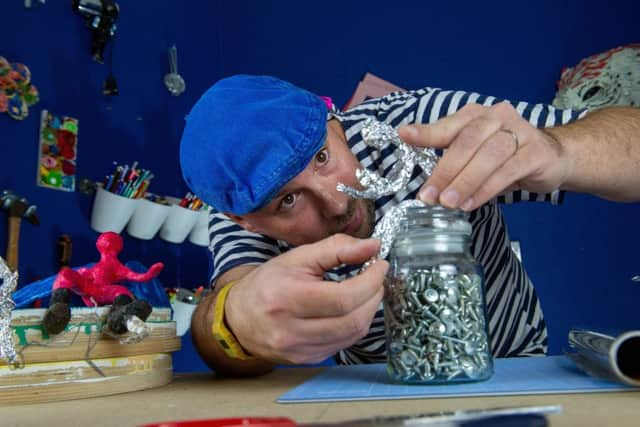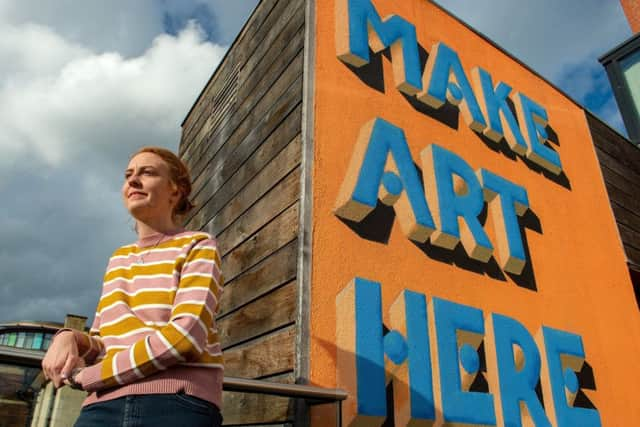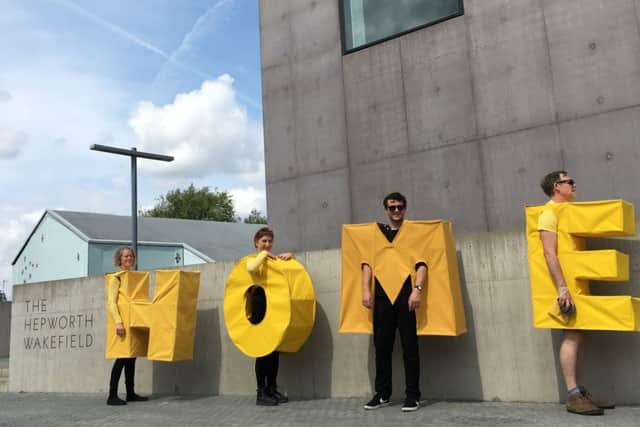Meet the artists putting Wakefield’s cultural scene on the map
Whenever John Mayson describes the studio he rents in Wakefield to fellow artists based in London he has become accustomed to the sound of gentle weeping. When he tells them the cost of the monthly rent it generally escalates to full-scale sobbing.
Advertisement
Hide AdAdvertisement
Hide Ad“I have a front door, it’s warm, there’s a print room I can use whenever I want, there’s a cafe where I can get a cup of coffee, it has its own gallery and it’s ridiculously affordable,” says John of his space in the Art House, just a stone’s throw from the city’s Westgate station. “To have just one of those things would feel like a luxury in London, to have all of them would require the income of a city banker. I do feel incredibly spoilt, two years ago I was mostly working in the dark with just a blanket to keep warm.”


John’s joking, but only partly. After studying at Bretton Hall, the now defunct education college which once shared a home with the Yorkshire Sculpture Park (YSP), John moved to London and spent 13 years living and working in Peckham. Despite securing a residency with an East End primary school it was still difficult to make ends meet and when he and his wife began to look at moving out of the capital a return to his old stomping ground seemed a natural choice.
“None of my friends had ever visited Wakefield; some didn’t even know where it was,” says John, who specialises in producing YouTube tutorials to turn complete novices into art masters. “If I’m completely honest I did worry that I might be about to sever all the connections I had made in London.
“However, shortly after I moved to Wakefield I ended up working with a photographer on a shoot at Sandal Castle. Two week later those images, including one of me walking my dogs, appeared in the Tate Modern. That was evidence enough that this is a good place to be.”


Advertisement
Hide AdAdvertisement
Hide AdJohn – or ArtsJohn as he likes to be known – isn’t alone. Nick Vaughan also found his way to the Art House via Manchester and London, Scottish artist Rachel Sim now has a space at the city’s Westgate Studios and homegrown artists like Andy Singleton and Richard Wheater are increasingly making their names known outside of West Yorkshire.
“What I really love is that there is a DIY approach to the arts here,” says John. “Yes there is The Hepworth and the YSP which are both amazing, but Wakefield is also full of people who are willing to give things a go. If there isn’t an arts festival they will put one on, if they want to stage a music event they’ll just go ahead and do it. That happens in other places too, but here it is combined with a professionalism that you rarely get.”
It was partly in recognition of that can-do attitude that Wakefield was successful in securing a £4.4m slice of the Government’s new Cultural Development Fund. The announcement was made in January and the aim is that through strategic investment the cash pot will create 600 new jobs as well as a creative hub to nurture emerging talent.
While it may sound ambitious, Wakefield is not staring at an entirely blank canvas. The Hepworth, which opened in 2011, and the YSP, which recently celebrated its 40th anniversary, have together proved that the city is a big hitter when it comes to attracting international artists.


Advertisement
Hide AdAdvertisement
Hide AdThe works by Leeds-born Damien Hirst which arrived at the YSP over the summer as part of the inaugural Yorkshire Sculpture International have recently proved a big draw and the launch of the £30,000 biennial Hepworth Prize for Sculpture showed this is a city prepared to put its money where its mouth is.
However, what may prove key to Wakefield’s success is the dedicated band of unsung creative heroes. These are people like Dean Freeman who set up the city’s Long Division music festival in the same year as The Hepworth opened, but with significantly less fanfare. Back then it was a bit of a makeshift event, but it is now an established platform for emerging acts as well as attracting well-known names like Billy Bragg and Joy Division’s
Peter Hook. Crucially, it is also commercially successful and during this year’s event the artists who performed over five days in 15 different venues shared a £75,000 funding pot.
“Often when people are involved in the creative industries there is an expectation that they will do things for free,” says Amy Lilley, who co-founded arts organisation WE ARE with friend and fellow arts graduate Lucy Norton. “In Wakefield you tend to find that people not only recognise the value of the arts and understand that it if it is the way people make their living they deserve to be paid for it.
Advertisement
Hide AdAdvertisement
Hide Ad“That may sound like a small thing, but it’s not. When Lucy and I came back here after university we found that there was a real lack of opportunities for young artists and professionals in Wakefield.
“We decided that if those opportunities weren’t there, we might as well create them and that’s what we have spent the last six years doing. We’ve put on film nights, we’ve staged exhibitions and we also now run Crux, a city centre space where we can host events and gigs. It does feel like we are approaching a tipping point and that the arts are really becoming embedded in the fabric of the city.”
The success of Artwalk Wakefield, which every two months turns the city centre into a giant art gallery with bars, offices, schools and churches all opening after dark to host exhibitions and installations by local and visiting artists, suggests Amy is right.
Managed jointly by WE ARE and the Art House, at the last event in September hundreds of people turned out to experience the trail, which included everything from an installation inspired by tea drinking by local artist Roo Veeren to Talking Rhubarb Totem, Jason Wilsher-Mills’ giant inflatable homage to one of the city’s most famous exports.
Advertisement
Hide AdAdvertisement
Hide Ad“What I love is how eclectic the work is,” says Sydney Thornbury, who became artistic director of the Art House last year after a spell at London’s Blackheath Conservatoire. “I wanted to get out of the London bubble and I am so glad I did.
“During the summer we invited Harriet Hill to the city. She had people wandering around in giant yellow letters which spelt out ‘HOME’ interviewing those they met about what that word meant to them.
“You see that kind of thing going on every day in London, but it’s great that we can now inspire that same kind of work here and the final video was funny, uplifting and moving and a real celebration of Wakefield.”
The newly established Wakefield Cultural Consortium is also helping to push the city’s creative credentials, but it is some way off branding it the North’s answer to Hoxton.
Advertisement
Hide AdAdvertisement
Hide AdOn the night of the last Artwalk those heading to watch the dance piece being performed in the nave of Wakefield Cathedral couldn’t avoid walking past the long queue for the pop-up soup kitchen.
It was a stark illustration of the gap which exists in most towns and cities and despite the cash injection from the Cultural Development Fund the North also loses out when it comes to arts funding.
According to a 2017 report by the Institute for Public Policy Research, the arts in northern England would need an extra £700m to be on a par with London and, while the extra investment in city’s like Wakefield is laudable, it is unlikely to restore the balance.
Playwright John Godber, who was born in Upton, just a few miles from Wakefield, puts it more bluntly. “The arts can’t thrive on good will and fine intentions – they need funding. I don’t mean throwing thousands of pounds at organisations which parachute in and disappear, it has to support individuals and organisations over the long term.”
Advertisement
Hide AdAdvertisement
Hide AdGodber was the artistic director of Hull Truck Theatre for 25 years before he stepped down and formed a new company and a partnership with Wakefield Theatre Royal eight years ago. “There is a lot of good work going on and a lot of optimistic enterprises,” he says. “However, austerity has had a major impact, particularly in the North, and we can’t hide from that.”
While Godber is a specialist in German theatre, he has made his reputation on plays which are set against familiar British backdrops from the rugby club of Up ’n’ Under to the nightclub of Bouncers.
“To steal a quote from Alan Ayckbourn, we need good hospitals, we need good schools and we need good theatres because then well-educated healthy people have somewhere to go at night,” he says.
If Wakefield can deliver the latter with that £4.4m, it will be money well spent.
The next Artwalk Wakefield will take place on November 27. For more details go to artwalk.org.uk